What to expect when a plane hits a building. MiG 21 vs. "Plattenbau", Cottbus, E. Germany, 1975
On January 14th, 1975, Major Peter Makowicka, 33, is on a training mission with his Mikoyan-Gurevich MiG 21 SPS „849“. During approach on the military airbase Cottbus, German Democratic Republic (Eastern Germany), a cover latch on the engine compressor section, which has been insufficiently secured by a maintenance technician, opens. The engine draws air and switches off. He receives the order to deploy the ejection seat to save himself and let the plane go down.
He disobeys the order.
Makovicka pulls up to prevent the plane from crashing into the TKC [Textile Combinate Cottbus] with its thousands of workers, intending to let the plane crash into an empty field instead.
He doesn't get that far anymore. In the residential area behind the factory site, the aircraft grazes the roof of a building and at ~10.15 am pierces a "Plattenbau" (a 5-story large-panel system building) across the street.
Mackovicka and five women are killed on the spot.
fire department report
At 10.19, Commando Fire Brigade Cottbus receives the alert. TLF 15 1:3 [triple combination pumper] and LF 16 1:8 [fire engine] respond immediately.
At 10.20, citizen Erich Schroff calls the emergency number to report the plane crash, and the OD alarms the remaining forces of Commando F.
At 10.21, LF 16/II 1:4 [fire engine], SW 1:1 [foam engine], RTW 1:1 [ambulance], DL30 1:0 [turntable ladder] and LF 16/I, who are nearby for a sport event, are alerted via radio. Having observed the smoke cloud, they are already in preparation and march out without delay at 10:22.
Arrivals
10.15: TLF 15 G5
10.26: LF 16/I, LF 16/II, SW, RTW
10.28: DL 30 (to pick up the chief and 3 officers)
At the same time, a B 1000 type fire engine 1:5 arrives from the Textile Combinate's works fire service, four comrades follow by foot.
At 10.41, the VPKA's [People's Police District Office] Leader F arrives, who alarms the RAW's (Reichsbahn repair shops) fire engines at 10.46. Their TLF 1:3 and LF 8 - TS 8- STA 1:5 arrive at 10.51.
The NVA's [National People's Army] fire engines arrive almost simultaneously, as they had observed the crash and have practically the same distance to cover.
Coincidentally, seven DRK [German Red Cross] ambulances were nearby and can quickly transport the injured to the hospital.
Situation
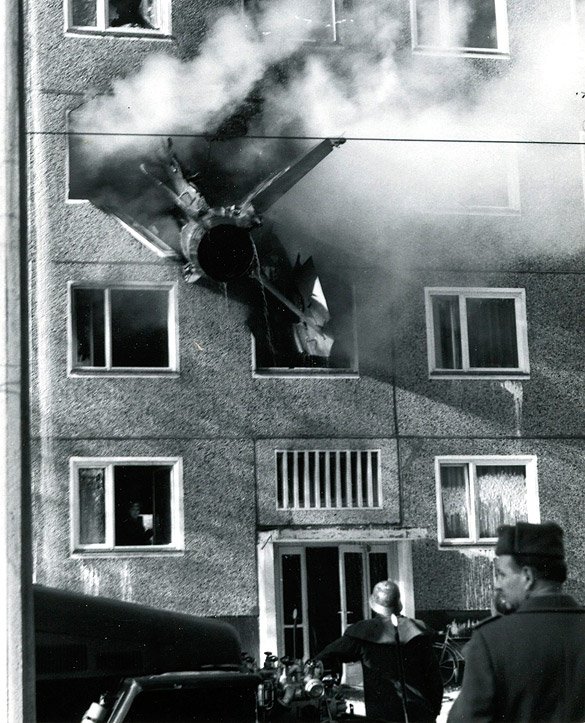
The plane had hit the second floor of the apartment block. The fire had spread from the basement to the 4th floor.
It is unknown
whether the plane carried ammo
whether all fuel tanks had burst and spilled
whether the security systems (pressure bottles) had responded or not
whether stability of the object was warranted despite the structural damage and fire exposure
whether the electrics were still live and explosive gas-air-mixtures had developed
The fire chief correctly deduces acute danger from explosions. No persons are visible in the windows or on the balconies, so he does not order deployment of the jumping blanket.
It is decided to attack the fire with the TLF from the street side and to evacuate the other entries. 18 doors are broken and the flats searched for civilians. The search is finished by 10.40.
The decisions later prove to be right. NVA comrades disclose that the plane still carried more than 800 liters of fuel. Upon impact, all four tanks had ruptured and the entire fuel escaped instantaneously, explaining the intensive burn and multiple, deflagration-like flare-ups on the 1st to 4th floors.
A stairwell advance is made impossible due to extremely high temperatures of ~1000°C. Constantly, molten aluminium and magnesium flows and drips down. The stair between the 1st and 3rd floor is destroyed. It would be irresponsible to endanger the firefighters.
The opening of the smoke dampers had caused an intense suction effect, causing the fire to spread quickly to all floors. The opening of apartment doors facilitates spreading to the flats.
Simultaneously, a second attack ("Section II") is staged from the west, or "balcony side". The initial attempt to use extinguishing foam is abandoned to prevent corrosive burns and suffocation of potential survivors.
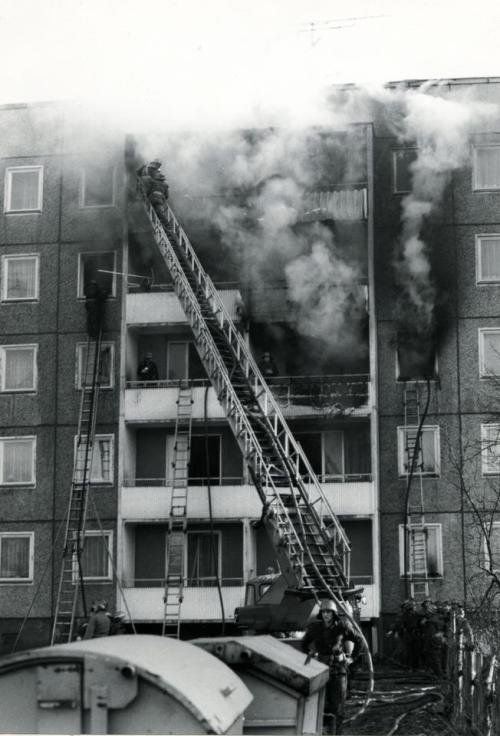
at 11.30 am
the whole building, suddenly and without forewarning, collapses from top to bottom in a rapid and symmetrical fashion reminiscent of controlled demolitions, drowning half of Cottbus in a thick cloud of fine-grained concrete powder. The very next day, representatives of the Warsaw Pact member nations convened to invoke the casus foederis and declared the global war on…
…oh sorry, wait, wait, wait, wrong script.
at 11.30 am
the fire is, by and large, extinguished.
All in all, 200-300 firefighters, police, medics and NVA soldiers are on the scene. Sixteen residents suffer severe injuries, many have jumped out of the windows in panic. One woman dies in hospital, raising the death toll of the accident to 7.
aftermath
The area is sealed off hermetically. Two days later, only a patch in the wall remains as evidence for what happened.
The newspaper "AND" reports only that a plane crashed, killing six people — and that an official commission has been tasked with the investigation.
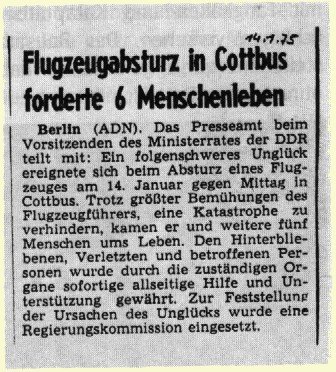
West German journalists get wind of the story. The Stasi (Ministry for State Security) documents how one journalist tries to contact a family in Cottbus to find out what happened. They also intercept letters from Cottbussers into the West, six are documented.
"That's something, isn't it? And you aren't even allowed to say a word! But one does wonder, after all…",
a letter to Darmstadt goes. One to Karlsruhe:
"The atmosphere is quite gloomy here. Hopefully the airfield is going to be relocated soon, this is the fourth plane to crash already…"
A teacher writes to Flensburg:
"Within two days you could hardly see a scratch on the building, all made new. In such things they are quick. Among the population, curses are the order of the day. Of course there are no protests. But I believe they will have to think of something now."
The technician who failed to close the latch properly was sentenced to five years in jail.
Major Peter Makowicka, likely the only NVA hero ever to disobey an order, posthumously receives the Kampforden für Verdienste um Volk und Vaterland in Gold (Combat medal for the merits for the People and Fatherland) and other awards.
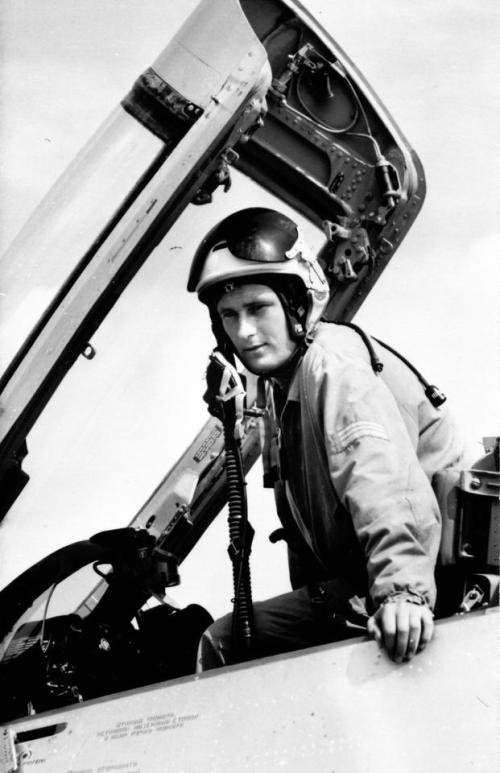
The building, Schmellwitzer Straße 2, Cottbus, stands to this day.
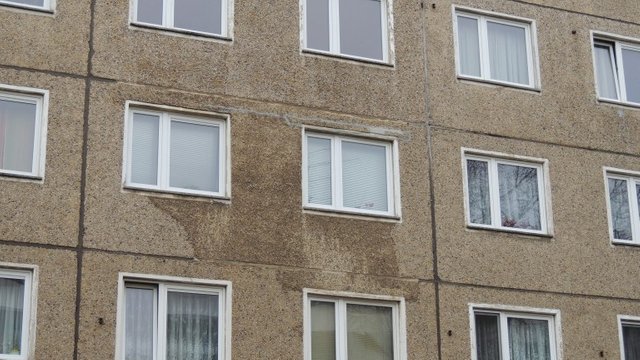
sources
- MiG-Absturz von 1975: Die Wahrheit über den Todes-Flug von Cottbus, B.Z., March 17, 2014
- der-jagdflieger.de - Gedenktafel
- Einschätzung des Einsatzes der Feuerwehren beim Flugzeugabsturz am 14.01.1975, Einsatzarchiv feuerwehr-cottbus.de
- Ein seltsames Motorengeräusch und dann eine Explosion, Lausitzer Rundschau, February 26, 2014
- Interactive Map, Lausitzer Rundschau
building vs. airplane
Empire State Building vs. B-25 Mitchell, New York; 1945
On Saturday, July 28, 1945, William Franklin Smith, Jr., was piloting a B-25 Mitchell bomber on a routine personnel transport mission from Bedford Army Air Field to Newark Airport. Smith asked for clearance to land, but was advised of zero visibility. Proceeding anyway, he became disoriented by the fog, and started turning right instead of left after passing the Chrysler Building. At 9:40 a.m., the aircraft crashed into the north side of the Empire State Building, between the 78th and 80th floors, carving an 18-by-20-foot (5.5 m × 6.1 m) hole in the building where the offices of the National Catholic Welfare Council were located. One engine shot through the South side opposite the impact and flew as far as the next block, dropping 900 feet and landing on the roof of a nearby building and starting a fire that destroyed a penthouse art studio. The other engine and part of the landing gear plummeted down an elevator shaft. The resulting fire was extinguished in 40 minutes. It is still the only fire at such a height to be brought under control. Fourteen people were killed. {Wikipedia}
40 Wall Street/"Trump Building" vs. Beechcraft C-45F, New York; 1946
On the evening of May 20, 1946, a United States Army Air Forces Beechcraft C-45F Expediter airplane crashed into the north side of the building. The twin-engined plane was heading for Newark Airport on a flight originating at Lake Charles Army Air Field in Louisiana. It struck the 58th floor of the building at about 8:10 PM, creating a 20-by-10-foot (6.1 m × 3.0 m) hole in the masonry, and killing all five aboard the plane, including a WAC officer. The fuselage and the wing of the splintered plane fell and caught onto the 12th story ledge. Fog and low visibility were identified as the main causes of the crash. At the time of the accident, LaGuardia Field reported a heavy fog that reduced the ceiling to 500 feet (150 m), obscuring the view of the ground for the pilot at the building's 58th story level. Parts of the aircraft and pieces of brick and mortar from the building fell into the street below, but there were no reported injuries to any of the estimated 2,000 workers in the building, nor anyone on the street. {Wikipedia}
Groeneveen & Klein-Kruitberg vs. Boeing 747-258F, Bijlmermeer, Amsterdam; 1992
At 6:35:42 pm local time, the aircraft nose-dived from the sky and slammed into two high-rise apartment complexes in the Bijlmermeer neighbourhood, at the corner of a building where the Groeneveen complex met the Klein-Kruitberg complex. It exploded in a fireball, which caused the building to partially collapse inward, destroying dozens of apartments. The cockpit came to rest east of the flats, between the building and the viaduct of Amsterdam Metro Line 53; the tail broke off and was blown back by the force of the explosion [...] First responders came upon a rapidly spreading fire of "gigantic proportions" that consumed all 10 floors of the buildings and was 120 meters wide, the length of a football field. There were no survivors from the crash point; only those who managed to escape from the remainder of the building. Witnesses reported seeing people jumping out of the building to escape the fire. {Wikipedia}
World Trade Center North Tower, South Tower & Salomon Building vs. Boeing 767-223ER & Boeing 767-222, New York; 2001
Two [...] planes, American Airlines Flight 11 and United Airlines Flight 175, were crashed into the North and South towers, respectively, of the World Trade Center complex in New York City. Within an hour and 42 minutes, both 110-story towers collapsed, with debris and the resulting fires causing partial or complete collapse of all other buildings in the World Trade Center complex, including the 47-story 7 World Trade Center tower, as well as significant damage to ten other large surrounding structures.
Pentagon vs. Boeing 757-223, Washington, D.C.; 2001
The impact severely damaged an area of the Pentagon and caused a large fire. A portion of the building collapsed; firefighters spent days working to fully extinguish the blaze [...] Flight 77, flying at 530 mph (853 km/h, 237 m/s, or 460 knots) over the Navy Annex Building adjacent to Arlington National Cemetery, crashed into the western side of the Pentagon in Arlington County, Virginia, just south of Washington, D.C., at 09:37:46. The plane hit the Pentagon at the first-floor level, and at the moment of impact, the airplane was rolled slightly to the left, with the right wing elevated. The front part of the fuselage disintegrated on impact, while the mid and tail sections moved for another fraction of a second, with tail section debris penetrating furthest into the building. In all, the airplane took eight-tenths of a second to fully penetrate 310 feet (94 m) into the three outermost of the building's five rings and unleashed a fireball that rose 200 feet (61 m) above the building. In all, there were 189 deaths at the Pentagon site, including the 125 in the Pentagon building in addition to the 64 on board the aircraft.
Bank of America Tower vs. Cessna 172, Tampa, Florida; 2002
The impact killed the teenager and damaged an office room. There were no other injuries. {Wikipedia}
Pirelli Tower vs. Rockwell Commander 112, Milan, Italy; 2002
The vibration of the crash caused shop windows to break and littered the surroundings with debris and glass. The pilot and two lawyers present inside the building died. Between thirty and forty people were taken to the hospital with moderate injuries, while fire-fighters contained the fire that resulted from the crash. {Wikipedia}
Belaire vs. Cirrus SR20, New York; 2002
The aircraft struck the north side of the building [...] causing a fire in several apartments, which was extinguished within two hours. Both people aboard the aircraft were killed in the accident: New York Yankees pitcher Cory Lidle and his certified flight instructor Tyler Stanger. Twenty-one people were injured, including eleven firefighters. An apartment resident [...] was hospitalized for a month with severe burns incurred when the post-impact fire engulfed her apartment. {Wikipedia}
Echelon I vs. Piper Dakota, Austin, Texas; 2010
Generic brick building vs. Boeing 747, Johannesburg, South Africa; 2013
Images from Twitter appear to show the plane was taxiing when one of its wings sliced through a brick building on the edge of the runway. {Telegraph}
FlightSafety International Bldg vs. Beechcraft Super King Air, Wichita, Kansas; 2014
edit: forgot a word
great post, where did you get all this amazing info on such an isolated incident. Interesting to note that this building did not collapse 1 hour after the impact and fall into dust into its footprint like the two world trade towers and the building 7, that never even saw a plane ! But i guess that,s another story !!
We had a joke in Western Germany about the "Plattenbau", which is basically just a few sheets of prefabricated concrete slabs screwed together:
Two engineers stand on either side of the wall between two appartments.
"Can you hear me?" asks the one.
"Yes", the other one replies.
"Can you see me?"
"No."
"Well, I guess the wall is thick enough."
This type of building was extremely cheap and lightweight, in short: "socialistic". So I will let no arguments be counted that say "Ha! Even cheap German concrete slab engineering is superior to a century worth of NY architect's experience in steel frame and skyscraper design!"
...or "butbutbut a 767 is much taller and heavier than a MiG!" - of course it is. But there is also the difference between a 5-story concrete slab building and a 110-story tower with hundreds of steel columns.
What I found interesting was the observation of molten aluminum in the staircase, BTW. It made me reconsider the flow from the NE corner of the South Tower. It would be interesting whether it also glowed in such bright tones...
And the irony, of course, is in the two regimes' different reactions to the incident. One covered up the incident altogether and attempted to control the flow of information outside town, the other made a world wide media spectacle out of it, simply destroyed all evidence and made a public cover-up of the "investigation".
Well i have not much to add to this brilliant anecdote which i think sums up the situation we saw on 911 perfectly !! Hitler,s propaganda chief Goebbels,s said that when you make a lie big enough, nobody will dare disbelieve it !! I would love to have seen this posted 10 days ago !! Thank you so much for sharing this incredible story and your brilliant reply. I am happy to see that I am apparently already following your posts here. Steem on to Truth @akareyon.